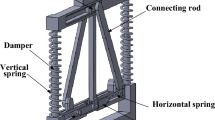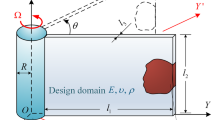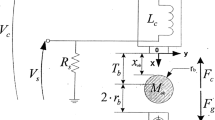Abstract
In this paper we discuss the adjoint sensitivity analysis and optimization of hysteretic systems equipped with nonlinear viscous dampers and subjected to transient excitation. The viscous dampers are modeled via the Maxwell model, considering at the same time the stiffening and the damping contribution of the dampers. The time-history analysis adopted for the evaluation of the response of the systems relies on the Newmark-β time integration scheme. In particular, the dynamic equilibrium in each time-step is achieved by means of the Newton-Raphson and the Runge-Kutta methods. The sensitivity of the system response is calculated with the adjoint variable method. In particular, the discretize-then-differentiate approach is adopted for calculating consistently the sensitivity of the system. The importance and the generality of the sensitivity analysis discussed herein is demonstrated in two numerical applications: the retrofitting of a structure subject to seismic excitation, and the design of a quarter-car suspension system. The MATLAB code for the sensitivity analysis considered in the first application is provided as “Supplementary Material”.













Similar content being viewed by others
References
Almazán JL, Espinoza G, Aguirre JJ (2012) Torsional balance of asymmetric structures by means of tuned mass dampers. Eng Struct 42:308–328
Argyris JH, Mlejnek HP (1991) Dynamics of structures. North Holland
Brodersen ML, Høgsberg J (2016) Hybrid damper with stroke amplification for damping of offshore wind turbines. Wind Energy 19(12):2223–2238
Caetano E, Cunha A, Moutinho C, Magalhaes F (2010) Studies for controlling human-induced vibration of the Pedro e Ines footbridge, Portugal. Part 2: implementation of tuned mass dampers. Eng Struct 32(4):1082–1091
Casado CM, Diaz IM, de Sebastian J, Poncela AV, Lorenzana A (2013) Implementation of passive and active vibration control on an in-service footbridge. Struct Control Health Monit 20(1): 70–87
Charmpis DC, Komodromos P, Phocas MC (2012) Optimized earthquake response of multi-storey buildings with seismic isolation at various elevations. Earthq Eng Struct Dyn 41(15):2289–2310
Chopra AK (2011) Dynamics of structures: theory and applications to earthquake engineering. Prentice-Hall, Englewood Cliffs
Constantinou MC, Soong TT, Dargush GF (1998) Passive energy dissipation systems for structural design and retrofit. Multidisciplinary Center for Earthquake Engineering Research Buffalo, New York
Dahl J, Jensen JS, Sigmund O (2008) Topology optimization for transient wave propagation problems in one dimension: design of filters and pulse modulators. Struct Multidiscip Optim 36(6): 585–595
Daniel Y, Lavan O (2015) Optimality criteria based seismic design of multiple tuned-mass-dampers for the control of 3D irregular buildings. Earthq Struct 8(1):77–100
Dargush GF, Sant RS (2005) Evolutionary aseismic design and retrofit of structures with passive energy dissipation. Earthq Eng Struct Dyn 34(May):1601–1626
Elesin Y, Lazarov BS, Jensen JS, Sigmund O (2012) Design of robust and efficient photonic switches using topology optimization. Photon Nanostruct - Fundamentals Appl 10(1):153–165
Georgiou G, Verros G, Natsiavas S (2007) Multi-objective optimization of quarter-car models with a passive or semi-active suspension system. Veh Syst Dyn 45(March 2015):77–92
Gurobi Optimization Inc. (2016) Gurobi Optimizer Reference Manual. http://www.gurobi.com
Haftka RT, Adelman HM (1989) Recent developments in structural sensitivity analysis. Struct Optim 1 (3):137–151
Infanti S, Castellano MG (2007) Sheikh Zayed bridge seismic protection system. In: 10th world conference on seismic isolation, energy dissipation and active vibrations control of structures, number May. Istanbul, Turkey
Infanti S, Papanikolas P, Benzoni G, Castellano MG (2004) Rion antirion bridge: design and full–scale testing of the seismic protection devices. In: 13th world conference on earthquake engineering. Vancouver, B.C., Canada
Infanti S, Robinson J, Smith R (2008) Viscous dampers for high-rise buildings. In: 14th world conference on earthquake engineering (14WCEE), number July. Beijing, China
Jensen JS, Nakshatrala PB, Tortorelli DA (2014) On the consistency of adjoint sensitivity analysis for structural optimization of linear dynamic problems. Struct Multidiscip Optim 49(2006):831–837
Kanno Y (2013) Damper placement optimization in a shear building model with discrete design variables: a mixed-integer second-order cone programming approach. Earthq Eng Struct Dyn 42(11):1657–1676
Kasai K, Oohara K (2001) Algorith and computer code to simulate nonlinear viscous dampers. In: Passively controlled structure symposium, Yokohama, Japan
Klembczyk AR, Mosher MW (2000) Analysis, optimization, and development of a specialized passive shock isolation system for high speed planning boat seats. Technical Report, Taylor Devices Inc. and Tayco Developments Inc., North Tonawanda
Lavan O, Levy R (2005) Optimal design of supplemental viscous dampers for irregular shear-frames in the presence of yielding. Earthq Eng Struct Dyn 34(8):889–907
Lavan O, Levy R (2010) Performance based optimal seismic retrofitting of yielding plane frames using added viscous damping. Earthq Struct 1(3):307–326
Lavan O, Amir O (2014) Simultaneous topology and sizing optimization of viscous dampers in seismic retrofitting of 3D irregular frame structures. Earthq Eng Struct Dyn 43:1325–1342
Lavan O, Levy R (2006a) Optimal peripheral drift control of 3D irregular framed structures using supplemental viscous dampers. J Earthq Eng 10(6):903–923
Lavan O, Levy R (2006b) Optimal design of supplemental viscous dampers for linear framed structures. Earthq Eng Struct Dyn 35(3):337–356
Le C, Bruns TE, Tortorelli DA (2012) Material microstructure optimization for linear elastodynamic energy wave management, vol 60
Miyamoto HK, Taylor D (2000) Structural control of dynamic blast loading. In: Proceedings from structures congress on advanced technology in structural engineering, 2000, pp 1–8
Nakshatrala PB, Tortorelli DA (2016) Nonlinear structural design using multiscale topology optimization. Part II: Transient formulation, vol 304
National Information Service for Earthquake Engineering - University of California Berkeley (2013) 10 pairs of horizontal ground motions for Los Angeles with a probability of exceedence of 10% in 50 years
Oohara K, Kasai K (2002) Time-history analysis model for nonlinear viscous dampers. In: Structural engineers world congress (SEWC). Yokohama, Japan
Pollini N, Lavan O, Amir O (2016) Towards realistic minimum-cost optimization of viscous fluid dampers for seismic retrofitting. Bull Earthq Eng 14(3):971–998
Pollini N, Lavan O, Amir O (2017) Minimum-cost optimization of nonlinear fluid viscous dampers and their supporting members for seismic retrofitting. Earthq Eng Struct Dyn 46:1941–1961
Quarteroni A, Sacco R, Saleri F (2007) Numerical mathematics, volume 37 of Texts in Applied Mathematics. Springer, Berlin
Seleemah AA, Constantinou MC (1997) Investigation of seismic response of buildings with linear and nonlinear fluid viscous dampers. Technical Report. University at Buffalo, Buffalo
Simon-Talero M, Merino RM, Infanti S (2006) Seismic protection of the Guadalfeo bridge by viscous dampers. In: 1st European conference on earthquake engineering and seismology, number September. Geneva, Switzerland, pp 3–8
Sivaselvan MV, Reinhorn AM (2000) Hysteretic models for deteriorating inelastic structures. J Eng Mech 126(6):633–640
Smith RJ, Willford MR (2007) The damped outrigger concept for tall buildings. Struct Design Tall Special Buildings 16(4):501–517
Soong TT, Dargush GF (1997) Passive energy dissipation systems in structural engineering. Wiley, New York
Suciu CV, Tobiishi T, Mouri R (2012) Modeling and simulation of a vehicle suspension with variable damping versus the excitation frequency. J Telecommun Info Technol 2012(1):83–89
Svanberg K (1987) The method of moving asymptotes—a new method for structural optimization. Int J Numer Methods Eng 24(June 1986):359–373
Takewaki I (1997) Optimal damper placement for minimum transfer functions. Earthq Eng Struct Dyn 26 (February):1113–1124
Taylor D (2015) Personal comunication
Tortorelli DA, Michaleris P (1994) Design sensitivity analysis overview and review. Inverse Prob Eng 1 (December 2013):71– 105
Turteltaub S (2005) Optimal non-homogeneous composites for dynamic loading. Struct Multidiscip Optim 30 (2):101–112
Yang JN, Agrawal AK, Samali B, Wu J-C (2004) Benchmark problem for response control of wind-excited tall buildings. J Eng Mech 130(4):437–446
Yun K-S, Youn S-K (2017) Design sensitivity analysis for transient response of non-viscously damped dynamic systems. Struct Multidiscip Optim 55(6):2197–2210
Acknowledgements
The authors would like to thank the anonymous reviewers for their helpful comments. The research presented in this paper was founded by the Israeli Ministry of Science, Technology and Space. The authors gratefully acknowledge this financial support.
Author information
Authors and Affiliations
Corresponding author
Electronic supplementary material
Below is the link to the electronic supplementary material.
Appendix:: Explicit formulations of the matrices involved in the sensitivity analysis
Appendix:: Explicit formulations of the matrices involved in the sensitivity analysis
To perform the sensitivity analysis discussed in Section 3, (27) must be solved iteratively backwards over the same time discretization adopted in the system response analysis. The matrix A g r,i , and the vector b g r,i have been partitioned into blocks in order to facilitate their description. More precisely, the block \(\mathbf {A}^{11}_{i}\) of A g r,i is also a matrix and it is presented in Table 5. The blocks \(\mathbf {A}^{12}_{i}\) and \(\mathbf {A}^{21}_{i}\) are the following:
Finally, the block \(\mathbf {A}^{22}_{i}\) is defined in Table 6.
Similarly, the blocks of the vector b g r,i are also vectors, and they are written as follows:
where \(\dot {u}_{i+\frac {1}{2}} = \frac {1}{2}\left (\dot {u}_{i + 1}+\dot {u}_{i}\right )\). We remark that Δt i+ 1 = t i+ 1 − t i , and Δt i = t i − t i− 1.
Rights and permissions
About this article
Cite this article
Pollini, N., Lavan, O. & Amir, O. Adjoint sensitivity analysis and optimization of hysteretic dynamic systems with nonlinear viscous dampers. Struct Multidisc Optim 57, 2273–2289 (2018). https://doi.org/10.1007/s00158-017-1858-2
Received:
Revised:
Accepted:
Published:
Issue Date:
DOI: https://doi.org/10.1007/s00158-017-1858-2




